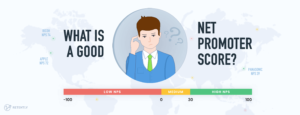If you’re part of a brand management or customer success consultancy, Net Promoter Score® could be the all-in-one customer satisfaction metric you’ve been looking for.
Designed to accurately assess customer sentiment, Net Promoter Score has several benefits that other customer satisfaction metrics don’t.
It’s short and simple, built around a one-question survey. This makes it easy for customers to respond and reduces the level of hesitation common to long, complicated satisfaction surveys.
It’s also highly actionable. Since NPS® gives you both a quantitative score and real, qualitative feedback, acting on the advice and information you receive from customers is a quick, simple and straightforward process.
In this guide, we’ll look at several strategies you can use as a brand manager or customer success consultant to help your clients improve customer satisfaction and increase retention using Net Promoter Score.
Use NPS to establish a baseline customer satisfaction score
As a customer success consultant, your goal is to help your clients build stronger relationships with their customers.
In order to measure the strength and value of a client’s relationship with its customers, it’s vital to have an accurate, quantified baseline control.
One of the easiest ways to start using Net Promoter Score in your consultancy is to measure the threshold customer satisfaction score for each client before you begin to take action.
After you take on a new client and establish objectives, try sending out a Net Promoter Score survey using Retently CX. Since you haven’t yet implemented anything, the data you receive can serve as a baseline score that you can use to measure changes over time.
As well as giving you the data on your client’s existing Net Promoter Score, your first NPS survey can also be a great source of detailed and actionable customer feedback.
Since you’re just getting started, this feedback can be extremely helpful for discovering sources of frustration that affect customers and establishing your top priorities for improving relationships and enhancing customer satisfaction.
It’s impossible to accurately measure the effects of your work without baseline data. Use NPS to quickly and efficiently calculate each client’s customer satisfaction level and you’ll find it easy to demonstrate the positive effects of your work as a consultant.
Follow up after 30 to 60 days to assess changes
After establishing a baseline customer satisfaction score for each client, you can use Net Promoter Score to keep track of progress over time.
We’ve found that sending a follow-up survey 30 to 60 days after implementing a major update is an easy way to assess customer satisfaction and view changes in the way customers feel about your client’s product or service.
While you’ll unlikely see significant changes in customer satisfaction within the first month, a few positive updates are usually enough to produce a measurable, statistically significant positive effect on a client’s Net Promoter Score.
As a brand manager or customer satisfaction consultant, this lets you show real progress in the short term and demonstrate that your work is producing measurable value.
Limit your NPS survey frequency to once every six months
As a general rule, it’s best to limit your Net Promoter Score survey frequency to once every six months.
Understandably, responding to surveys often can “burn out” customers and reduce your average response rate. Sending out a new survey every six months helps you strike a good balance that keeps feedback fresh and relevant without taking a toll on customers.
The exception to this rule is if your client implements changes rapidly and updates their product weekly or monthly. In this case, a quarterly update can make it easier to stay on top of customer satisfaction and tie improvements or reductions in satisfaction to specific events.
Whatever frequency you choose, never push a client to over-survey their customers. No matter how good your product or service might be, sending out surveys too often can result in annoyance and frustration, hurting your Net Promoter Score and earning negative feedback.
Work with your clients to close the loop and respond to feedback
One of the most common Net Promoter Score mistakes is using NPS as a purely quantitative feedback system, all while ignoring or forgetting to act on the qualitative feedback provided by customers.
The quantitative side of the Net Promoter Score can be volatile. Like all statistics, it’s affected by noise and depends on a large sample size to provide accurate results.
The qualitative feedback your clients receive from their customers is arguably more valuable than the score itself. Ignore it, and your clients risk missing out on valuable insights into how they can improve customer satisfaction.
As a brand management or customer success consultant, it’s essential to work with your customers to implement feedback and close the loop.
One way to do this is to set a deadline for responding to each round of customer feedback. If you make it a priority to respond to NPS feedback within 24 hours or less, there’s a far higher chance that your clients will read, value and respond to their customers.
Remember that closing the loop doesn’t always mean solving a problem immediately. If your client receives useful advice on a major problem from a customer, letting them know that you will act on their advice is often enough to improve sentiment in the short term.
As we covered in our guide to closing the customer feedback loop, showing a commitment to considering people’s feedback seriously differentiates a business from its competitors. Show customers that you’re listening and you can and will turn many of them into Promoters.
Segment your audience to make responding to feedback easier
For clients with large customer audiences, it’s important to segment customers before you send out your first NPS survey.
Surveying tens of thousands of clients at once can be great for statistical significance, but it’s also an easy way to overwhelm your customer success team with a huge volume of feedback. The end result is little or no progress, with your team’s time wasted on responses rather than action.
Before sending any NPS surveys, break your client’s audience down into smaller groups that you can easily manage. This way, there’s a lower risk of you becoming flooded with customer feedback all at once.
Segmenting your NPS audience also makes it easier to monitor progress, as you can send new surveys to each segment and track changes in each client’s Net Promoter Score after you solve flagged issues, implement new features and make other improvements.
Use NPS to help your clients build stronger relationships
Start off by personalizing the customer experience, which is one of the main factors in driving customer consideration and loyalty. Based on available research, companies with a strong focus on personalization experience a 40% boost in revenue compared to their counterparts in the market. This statistic aligns with consumer expectations, as 72% of them want businesses to understand their interests.
Encourage your clients to invest in customer relationships beyond mere transactions and use NPS feedback to tailor communication and offers based on needs and preferences. Secure considerate touchpoints in the customer journey, such as targeted post-service or post-purchase follow-ups to show commitment to customer success.
As a brand management and customer success consultant, help your clients develop strategies to improve employee satisfaction and nurture a customer-centric mindset. Advise your clients to share NPS feedback with their employees as a means to create awareness of customer sentiment. Employees who understand user needs will inevitably deliver better service, enhance brand reputation and increase customer lifetime value.
NPS should not be viewed as a one-time survey but as part of an ongoing relationship. Regularly collecting NPS data and monitoring the scores, timely addressing customer concerns and consistently aiming to exceed customer expectations will drive growth and positive brand perceptions in the long run. Yet, your guidance as a brand management and customer success consultant will be essential in helping your clients leverage NPS to achieve these outcomes.
Bottom line
Do you use Net Promoter Score as part of your brand management or customer satisfaction consultancy? From improving retention to enhancing satisfaction, NPS can help you produce actual results and progress for your clients.
Learn more about NPS in our Ultimate Guide to Net Promoter Score, or register for a free trial account to begin using Retently now as part of your customer satisfaction toolkit.






























 Alex Bitca
Alex Bitca 

 Greg Raileanu
Greg Raileanu 



 Christina Sol
Christina Sol